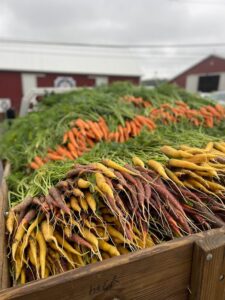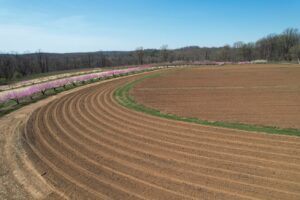Regenerating Sustainability
Regenerating Sustainability
If you were to ask anyone about the term sustainability, you would learn that it can mean a variety of different things to different people. Sustainability in farming takes up an important space in the conservation as it contends with feeding people healthy and nutritious food now and into the future. Soil, water, and air… Read More »

The majority of the food that we consume is produced in soil which makes managing this valuable resource an important priority for a farmer. According to the United Nations, the world has about 60 years of topsoil left illustrating the importance of farming methods geared towards increasing soil viability and organic matter.
Why Farm Sustainably?
One of the fundamental goals of sustainable farming is improving the soil’s fertility. Healthy soil is the key to thriving plants, nutritious food, and viability for food in our future. Sustainability in agriculture involves an integrated system of practices that enhances the natural environment and improves ecology & biodiversity while enhancing the community and economic development of the region.
We embrace the principles of sustainable farming techniques including crop rotation,
Sustainable farming practices include the use of trickle irrigation which conserves water and reduces soil erosion. Irrigation is targeted at the roots of the plant reducing water usage and minimizing soil runoff. Another important part of sustainable farming is integrated pest management which is a strategy that reduces the pest’s ability to thrive. This is done through a variety of methods such as; creating conditions that are unfavorable for the pest, introducing natural pest predators, or by habitat manipulation, all aimed at long-term prevention of pests and healthier crops.
Healthy soil allows water to percolate, improving drainage and reducing wet site conditions. We incorporate mulch and other organic matter several times a year to improve soil structure and make it better. You can learn more about other methods we use to grow healthy soil here. Watch a fun video about the process of nourishing the soil by clicking here.
We also go one step further with our sustainability goals with the implementation of regenerative agriculture on our farm. Regenerative agriculture is a synergistic approach to improving the soil by managing whole systems and landscapes and preserving natural resources in our care. Regenerative ag is a holistic desire to improve ecosystem health with the hope of leaving our land in better shape for future generations. Some examples of our regenerative farming practices include carbon sequestration, overwintering, composting, and no-till farming. Regenerative farming’s holistic approach takes into consideration the health of farmers, workers, animals, and the community.
One simple, yet impactful practice of regenerative ag includes the conservation of natural buffers such as hedgerows. The hedgerows that line farm fields function as wind barriers and habitats for beneficial wildlife and organisms. We do our part to keep them at a healthy balance, not too large and overgrown, yet present for it’s assistance in farming. Another important part of regenerative agriculture is to bolster the community ensuring it’s resilience, viability, health and nutrition. Helping keep the community strong means improving the local economy through monies spent in the community, increasing access to nutritious food, and creating more jobs. Read more about our regenerative farming practices and the additional steps we use to grow healthy soil on our website.
We are proud to highlight all the ways that we care for the environment while growing healthy food, healthy soil and healthy communities! We invite you to learn more about how food is grown with a trip to our farm to get to know more about your farmer and your food.
Alstede Farms is a forerunner in sustainable agriculture with over 600 acres of preserved farmland in Morris County. You can learn more by visiting our website www.alstedefarms.com
Watch Rebekah discuss the three pillars of sustainability we utilize on our farm in this video.







